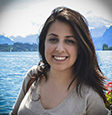Before meeting with K2.0 at Kafja e Vogel in Prishtina, a bar owned by his brother, Sokol Beqiri passes the time before his interview making conversation with friends over some drinks. He considers this activity much closer to art, or whatever it means to make art, than any of the works that have turned him into one of Kosovo’s most renowned artists.
For Beqiri, the borderlines between life and art are almost indiscernible, and life may be the most important kind of art there is. It is this conviction that has made him increasingly averse to the art world, where ‘art’ is only that which appears in the hostile interiors of galleries.
The extent to which Beqiri prioritizes his relations with others above all is evident in his warm hospitality and easy going demeanor. Since famously declaring just over a decade ago that art had ended, Beqiri now devotes himself to this other form of artistry, spending his days managing his own cafe, Exit, in his native Peja.
Before declaring the end of his art career, Beqiri was best-known for his gruesome works in response to the Kosovo War. The most well-known of these works is his series “The End of Expressionism: Painted by a Madman” (2001), which includes the projects “Milka” (1999) and “When Angels are Late” (2001).
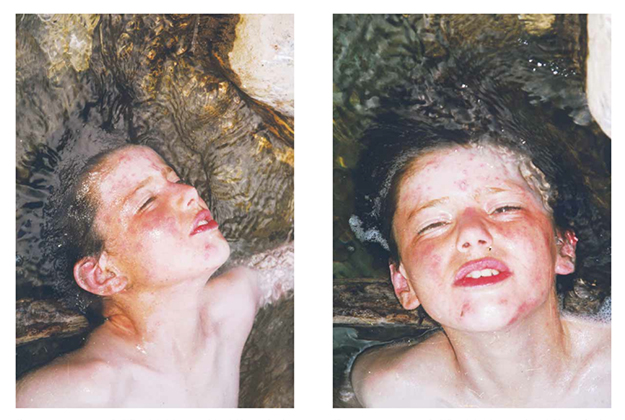
Sokol Beqiri’s series “The End of Expressionism” included some distressing images from the Kosovo war but attempted never to make accusations against the perpetrators. Photo courtesy of the National Gallery of Kosovo.
In responding to the brutality of war, Beqiri was always careful never to use art as a means of accusing the enemy. Art, for Beqiri, had to be bigger than that — it had to aspire to the universal in order to arrive at some authentic humanity that transcends mutilation by war, politics, and ideology.
Reflecting on this period of his work, Beqiri says, “the suffering of the Kosovar can be portrayed in art as a Kosovar cry, and this is OK, it can be a truth, a tangible, very emotional, piece of evidence of the time. However, if you stop only at this, you fall into a trap. It is true that you suffer and cry as an Albanian, but it is truer that you suffer and cry as a human.”
Today, while his beliefs about war and suffering may be the same, Beqiri says that if he could go back, he would not have bothered to make those works at all.
He is one of three Albanian artists that have been invited to exhibit at one of the largest and most eminent international art exhibitions in the world, documenta 14, that took place over this summer in Kassel and Athens, the German leg of which will continue until Sept. 17. This year also marks the first time in over a decade that Beqiri has completed a work: “Adonis,” a grafted oak tree, which was exhibited at a documenta showing in Athens.
K2.0 sat down with Beqiri to discuss this recent showing, and what his stance is on art today.
K2.0: You are often described as a ‘provocative’ artist. What do you make of this label? Do you intentionally make work that you know will be seen as provocative, or do you think that people just interpret it this way?
Sokol Beqiri: It’s true that people often call me provocative, but I have never had the intention of provoking or to create a scandal or anything like that. I have simply dealt with themes that are often received that way. I’ve been provoked by the themes I work with.
In another interview, you have said that in your daily life, you are a localist, but in art, you cannot be a localist. What do you mean when you say that?
Without being a localist, you can’t be anything. However, when I take the local problem, I don’t approach it locally. Because war cannot only be local, it automatically emerges in another dimension.
What I have tried, when I have dealt with the topic of war, was to not leave any element that can indicate to the viewer where that war took place. I have taken the war here and treated it as war. It cannot be local — if it is, you have to incorporate patriotism, these kinds of things… do you understand what I mean? In this sense I am not a localist, but I am a localist in the sense that I love the place I come from, beginning from my family, to my city, and so on.
You have said that art cannot be used as a tool against an enemy, since this relies on presumption that you think you are right to hate and fight the enemy, without fighting yourself simultaneously. Can you speak more about this?
The first mistake that is made when art is used as a tool is that you generalize all Serbians, for example, according to one belief. It is an immediate mistake that cannot be redeemed, because this is not a matter of generalization. The weight of your message is undermined if you generalize. Many times, this mistake has been exploited by political elites, and the intrinsic value of a work is lost when it is co-opted for political, nationalist, religious, or ideological purposes. It loses its force. So I think art should never be used as a tool for making accusations.
Without introspection you cannot have progress. You will fall behind if you don’t attempt to find the fault within yourself, in every sense, not only in the creative. If you are not doing that it is completely pointless to shame others. There is no development. For me, development occurs when you find the mistakes within yourself and arrive at a higher place. This is the essence of development: to begin from yourself, your family, and move farther out.
Do you consider your art political?
It is political, it is unfortunately political because politics has been mixed in with our lives much more than it ever should have been. I myself felt the need to react. I couldn’t afford to be painting flowers and joyful things when people were dying before my eyes. That is imposed. The politics is simply in that which is imposed. My work is political because I reacted to my reality. I have always tried to react as directly as possible to the circumstances, the phenomena, and the scenes around me. After politics and war invaded our lives, I had nowhere to go.
Maybe I would have been happier if I hadn’t bothered taking up these themes in my work. Or if I hadn’t painted at all.
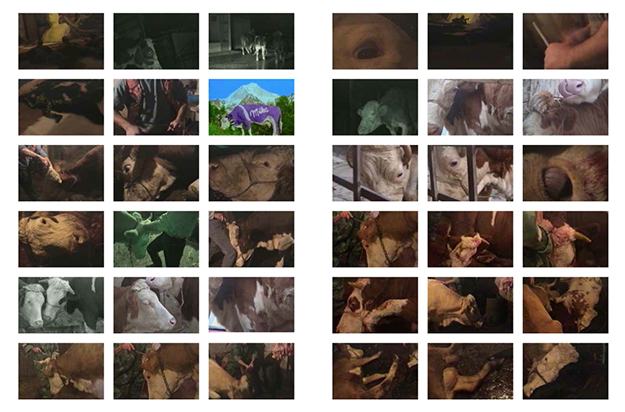
Beqiri’s 1999 video project, “Milka,” parables the massacres of the Kosovo War with the industrial mass slaughter of cows. Photo courtesy of the National Gallery of Kosovo.
There is a quote by the German philosopher Theodor Adorno that is frequently evoked in relation to your work. Writing after the Second World War, Adorno said that after Auschwitz, to write poetry is barbaric. How have you interpreted this quote and how does it inform your work?
It is true that this quote has influenced me, as is probably evident by the fact that for 10 years I have not wanted to deal, and have not dealt with art. Ten years ago I declared that after the war we saw here, art was dead. Who am I to be moralizing about how cows shouldn’t be slaughtered, how people shouldn’t be killed?
Usually, from the moment I think of a concept to the moment that I finish a piece, about four to five years will pass. “Milka,” as a project, was conceived before the war, before ’97. After the war, with the international community’s interest focused here, I started making projects that I had already planned. I had a lot of projects that I hadn’t realized, and many offers from well-known curators.
I continued to make work until 2006, when I decided that I didn’t want to work anymore, and declared it in the video “Everything You Always Wanted to Know About Art That You Are Afraid to Ask,” where I set alight my own fart.
This work ended with me concluding that I can’t find art outside of myself. For me, much more energy should be put into creating relationships with people, than into the production of art. I can’t find anything to express within myself that does not hinge on the relationships I have with people. Everything beyond that is vanity. Churning out an art product is a business… art is something that you have to practice in your daily life. That is what begs energy, begs force.
In an interview from 2006, after I had decided that art was dead, the interviewer asked me what I think the mission of the artist is. I said that I don’t believe in there being an artist’s mission, but if there is, it is to testify that there is no art. For me, the buying process is one way that I want to show that there is no art, that art is a trade and a business like everything else.
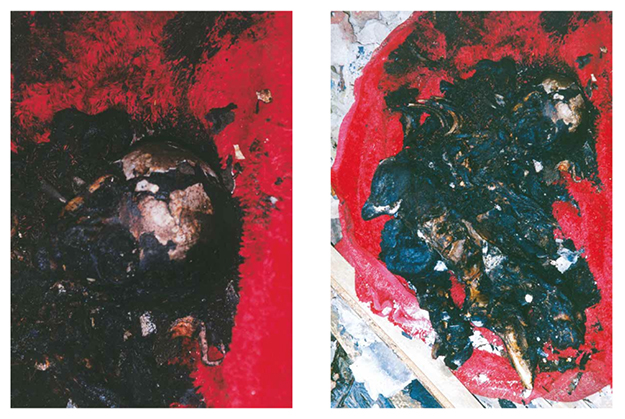
The End of Expressionism series also drew visual comparisons between horrific scenes from the Kosovar war and modern art. Photo courtesy of the National Gallery of Kosovo.
Was your series, “The End of Expressionism: Painted by a Madman” (2001) in any way a response to that statement by Adorno?
“The End of Expressionism” is a series that includes “Milka” and “When Angels are Late.” All of these works aim to show that expressionism ended with violence. The liberation of uncontrolled emotion ended with horrifying violence.
With that series I am profiting from barbarism. I am profiting from “Milka,” for example. You create the work and try to sell it for as much as you can.
The series includes four photographs. Two of them, with the red graphics, are documentary photographs that I found. When I first saw them, I had this urge to alter them in some way, so as to make a statement about the rights of people. At first sight they appear like the paintings of Alberto Burri, whose work I once loved.
One of the bodies was drowned, the other was killed, and they were burned in red flames, and this had taken a form that at first sight appears very beautiful, just like Burri’s paintings. And then you figure out the context.
Or there’s the young boy that lies in the water like an angel, like Jesus Christ, like a prophet — they had broken his neck and left him to drown. This is another one of the questions of relative beauty that Burri poses: You might very well perceive something as beautiful, but you don’t know what the context is.
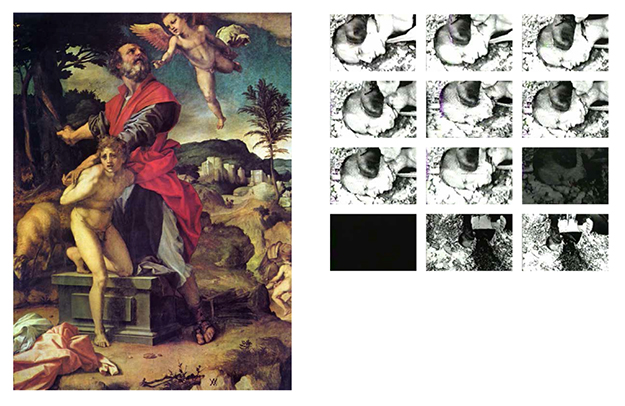
Beqiri’s 2001 series “When Angels are Late” shocked the public on its first exhibition, with its mix of classical themes and visceral violence. Photo courtesy of the National Gallery of Kosovo.
Were people horrified by those works?
Very much. That one and even more so “When Angels are Late.” That piece is a reproduction of a work of Andrea del Sarto’s, depicting Abraham about to sacrifice his son Isaac before an angel stops him, and it’s perhaps a juxtaposition between the illusion that art produces and reality.
In my reproduction, I’ve inserted a hole in the middle of the painting. When you get closer to it, you hear a voice, which draws you closer to look into the hole, and there you see a 20 second live footage of someone having their head beaten off. So this illusion that art produces, that the angel will come and hold out its hand, falls apart with that 20 second video.
In the painting and decorating project that you organized with children in 1999 in the ruins of Peja’s Grand Bazaar, which was burned during the war, you wore an original uniform left behind by a Serbian criminal. Rather than acting on your impulse to burn it, you subdued the crime it signified by painting the vest pink, the color, as you say, of “peace, understanding, and tolerance.” What were you trying to achieve here?
I had the urge to make something. I thought about how I would do it and decided to do it, but today I wouldn’t have bothered to do it at all. Because now I no longer believe that with art you can change anything. Art is repeatedly used by the political elite for ideological purposes, artists have always been tools, all their lives. I don’t think art is a way to triumph over political brutality. You can’t fight politics with art, you fight politics with politics.
Even as you exhibit in documenta 14 now, you maintain this same anti-art position?
After 2006, I was asked ‘what now?’ and I said: “I think I’ll start playing a new game, which is money.” I used to believe that with art you could really change the world, that art could do all these things. And now, OK, if it’s a business, we do business. I’m not trying to convince anyone that I’m doing it for Kosovo — I have yet to tell anyone that I am representing Kosovo at documenta. I’m only representing myself, no one else.
You have several works exhibited at documenta 14, one of which is a new one that you made in 2017, titled “Adonis.” Can you speak a bit about this piece?
For documenta, I was concerned with buying, not with making. After 13 years, after I’ve denied the originality of every idea, of every artist, all I want to know is what there is to buy, and where to sell. I asked someone if he could sell me his idea, and he did.
This was the most interesting part. I told him that it was for documenta, that I’m not an artist — that I just want to buy. I told him to give me the price, and we decided on 2,000 euros. It wasn’t a problem, as long as I had the right to put my name on it. Of course, in order to buy a work you need a contract, so I contacted a lawyer. I told him give me a declaration and I’ll buy it, and once you have a declaration, make a contract.
Since the concept of documenta is about global crisis, illustrated through the relations between Greeks and Germans, I’ve taken the oak planted in Kassel in 1982 and gone to Athens, at the National Technical University, where they first defeated the military dictatorship that had killed many students, and I grafted that tree there. I wanted to create a whole new relation between Greeks and Germans. I displaced it completely. This part is just trade, all you’re required to know is where and what to get, how to package, and how to sell.
I grafted the tree in Greece and created a video, the video which shows that I took the oak from Kassel, and went to Athens. With the video and the tree is exhibited a table, where the declaration, contract, payment documents, and the entire legal process involved in putting together the idea is displayed.
I titled it “Adonis” in order to create a virtual interrelation, I wanted to create a third tree, a third relation, and I wanted to find a tree in Greece that has a specific history, and I found out about a tree in the mountains of Greece, “Adonis,” the oldest tree in Europe.
Adonis is a symbol of beauty, and it interested me as a symbol of beauty that was born from an immoral act. A father slept with his daughter without knowing it, and the daughter gave birth. When the father found out, he wanted to shame her, because she supposedly deceived him. The daughter turns into a tree, and out of that tree Adonis is born. I liked the poeticism of this story, it added a poetic dimension to the piece.
So I have bought that piece, it’s not mine. We have learned to think about art as a sophisticated practice, and artists as people that have been touched by God — no, no. It’s just like making a hamburger. You have a canvas, the cook has the grill, you choose the right color, the cook chooses the right meat. It’s the same process for arriving to the result.
The differentiation is only that you are used to seeing the painting in the gallery, in order to create a certain illusion in you, and the hamburger, well, you just eat it without a second thought as to how it was made and who made it.
What do you say to those that claim that what you’re doing now, which is undermining art, reducing art to business, is still a form of art-making?
I need to live for something. I need to pay my bills. You want it, you ask for it. I mean, it should go like this: You are a curator, you have a concept, you invite me to your exhibition, because maybe you think, as Adam [Szymczyk, documenta curator] was thinking, that the way I have reacted is good, OK, if you think that I can do a project for you, I’ll do it. I’ll propose you a project, you like the project, and I’ll immediately tell you the price. I have a price — like a prostitute. Yeah, you want to have fun? Well it’ll cost you this much.K
This interview was conducted in Albanian and translated to English. It has been edited for length and clarity.
Feature image: Atdhe Mulla / K2.0.





